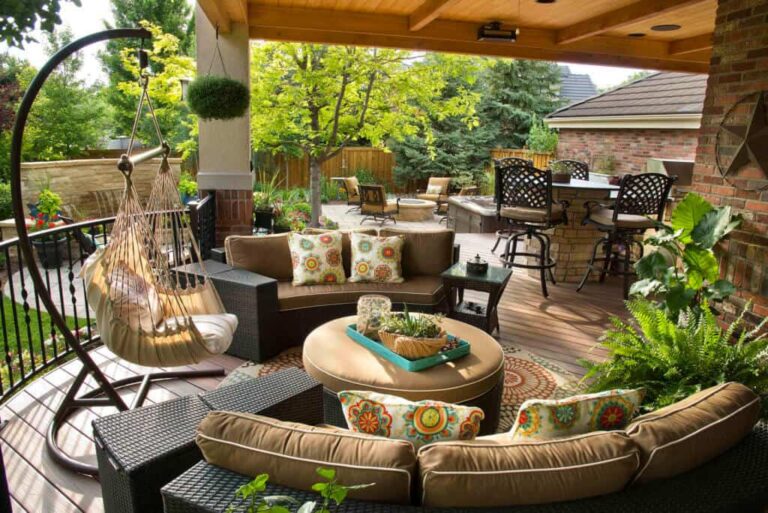Hi there! I’m so excited to talk with you today about something I’ve become completely obsessed with over the past few years – creating outdoor spaces that actually make you feel good. Not just look pretty in photos, but spaces that calm your mind the minute you step into them.
When my family moved to our current home five years ago, our backyard was basically a rectangle of patchy grass with one sad tree. I had no idea what I was doing, but I knew I wanted a space where I could breathe easier after stressful days. Through lots of mistakes, plant casualties (RIP my first attempt at growing lavender), and countless trips to the garden center, I’ve learned how our outdoor spaces affect our minds in ways we don’t even realize.
So grab your favorite drink, get comfy, and let’s chat about how to create an outdoor space that feels like the best kind of therapy – the kind that happens naturally when you’re surrounded by the right elements.
The Psychology Behind Outdoor Spaces
I didn’t know this when I started, but there’s actual science behind why certain outdoor spaces make us feel so good. Our brains are hardwired to respond to nature in ways that lower stress hormones, improve mood, and even help us think more clearly.
Remember when you were a kid and running through the sprinklers or watching ants on the sidewalk could keep you entertained for hours? That connection to nature isn’t something we outgrow – we just forget about it. Studies show that even five minutes in a natural setting can reduce blood pressure and anxiety.
The best part is that we can deliberately design our outdoor spaces to tap into these benefits. It doesn’t matter if you have a tiny apartment balcony or a sprawling yard – the principles work anywhere.
I learned this firsthand when I created a small corner in our yard with just a bench under our maple tree. That simple spot became where I gravitated whenever I felt overwhelmed. I couldn’t explain why until I started reading about biophilic design – our innate need to connect with nature.
10 Ideas to Create Calm Outdoor Spaces Through Design
Creating a peaceful outdoor space isn’t about following strict rules or spending tons of money. It’s about understanding what makes humans feel naturally at ease and working with what you have.
When I first tackled our backyard, I tried to do everything at once and ended up with a jumbled mess that didn’t feel cohesive. Now I know better – it’s all about intentional choices that work together. Here are ten approaches that have made the biggest difference in my space and for friends I’ve helped with their yards.
Use Natural Materials
There’s something about touching real wood, stone, or clay that just feels right to our senses. Our bodies know the difference between plastic and the real thing.
In my garden, I switched out the resin chairs for wooden ones, and even though they weren’t fancy, sitting in them immediately felt different. More grounded somehow. Same with planters – terracotta pots might be simple, but they have a warmth that plastic can’t match.
Try incorporating materials like:
- Wooden benches or stumps for seating
- Stone pathways instead of concrete
- Bamboo screens for privacy
- Woven wicker or rattan furniture
- Clay or ceramic pots for plants
These natural materials age beautifully too. My wooden bench has weathered to this gorgeous silver-gray that no store-bought finish could replicate.
Integrate Water Features
Water is like magic in an outdoor space. The sound alone can mask neighborhood noise and instantly make you feel calmer. Plus, water attracts birds and butterflies, adding life to your space.
You don’t need an elaborate setup. My first water feature was literally glass bird baths that cost $30 at a garage sale. That simple addition brought so many birds to our yard, and watching them splash around became my favorite morning ritual with coffee.
If you have more space or budget, consider:
- Small tabletop fountains
- Wall-mounted water features
- In-ground ponds
- Rain chains that turn downspouts into water features
- Simple bird baths (they’re perfect for smaller spaces)
The sound of moving water activates something primal in our brains that signals “all is well” – it’s like nature’s white noise machine.
Create Zones for Reflection and Quiet
One mistake I made early on was trying to make every inch of our yard useful for entertaining. But the spaces I ended up loving most were the tucked-away spots meant just for me.
Creating a dedicated spot for quiet time – even if it’s tiny – gives your brain permission to slow down. It signals “this is where I can just be.”
Some simple ways to create reflection zones:
- A single chair placed under a tree
- A small bench tucked into a corner with some screening plants
- A hammock strung between two posts
- A garden path that leads to a private nook
- Even just a stepping stone in a quiet part of the garden where you can stand and breathe
My favorite spot is a small area behind our shed that gets perfect morning light. I placed one comfortable chair there, surrounded by tall grasses. Nobody would even know it’s there unless I showed them – and that’s exactly why it works.
Add Comfortable, Inviting Seating
If seating isn’t comfortable, nobody uses it – no matter how pretty it looks. I learned this the hard way with some gorgeous but completely uncomfortable metal chairs that sat empty while everyone perched on the steps instead.
Comfort doesn’t have to mean expensive outdoor furniture. Sometimes the most inviting seats are the simplest:
- Adirondack chairs with wide arms for setting down a drink
- Weather-resistant cushions on basic benches
- Outdoor floor pillows for casual seating
- A porch swing with a simple cushion
- Even large, flat rocks positioned at the right height can make natural seating
The key is placing seating where people naturally want to be – in the shade during summer, in sunny spots during spring and fall, and with something interesting to look at rather than facing a blank fence.
Incorporate Aromatic Plants
Smell is our most powerful sense for triggering memories and emotions. When I planted lavender near our patio, I noticed people would unconsciously take deep breaths when sitting nearby.
Aromatic plants work double-duty – they look beautiful and create an experience that engages more of your senses. This makes your time outdoors more immersive and pulls you out of mental loops of worry or stress.
Some of my favorite aromatics that are fairly easy to grow:
- Lavender (needs full sun and good drainage)
- Rosemary (super hardy and drought-tolerant)
- Mint (careful, it spreads like crazy – keep it contained)
- Lemon thyme (smells amazing when you brush against it)
- Jasmine (for evening fragrance)
I like to place scented plants near seating areas or along pathways where you’ll brush against them and release their scent.
Use Soft, Natural Lighting
Lighting completely transforms outdoor spaces, especially in the evening. Harsh floodlights make any space feel like a stadium, while soft, warm lighting creates instant calm.
I replaced our bright porch light with string lights zigzagged overhead, and suddenly our patio became the place everyone wanted to hang out after sunset.
Some lighting approaches that create a peaceful vibe:
- String lights hung in trees or along fences
- Solar path lights that create pools of gentle light
- Lanterns with LED candles (safer than real flames)
- Uplighting on trees to create beautiful shadows
- Salt lamps or other warm-toned portable lights
The goal is to create enough light to move safely while maintaining that magical twilight feeling that helps us transition to evening relaxation.
Embrace Natural Color Palettes
Colors affect our mood in powerful ways. Bright primary colors energize us, while natural, muted tones tend to calm our nervous systems.
When I first planted our garden, I went crazy with every bright flower I could find. It looked like a crayon box exploded in our yard. Eventually, I realized the spaces that felt most peaceful used a more limited palette.
Try these color approaches for a calming effect:
- Blues and purples (lavender, sage, hydrangeas)
- Soft greens in various shades and textures
- White flowers that glow in evening light
- Silver-leaved plants that catch the breeze
- Gentle pinks rather than hot magentas
You don’t need to avoid bright colors entirely – just use them as accents rather than the main event. My orange California poppies look stunning because they’re surrounded by plenty of green and silver foliage that lets them shine.
Encourage Wildlife and Biodiversity
There’s something deeply satisfying about creating a space that supports other living things. When birds, butterflies, and bees visit your garden, it creates this wonderful feeling of connection to the larger world.
And honestly, watching a hummingbird hover at a flower does more for my stress levels than any meditation app.
Simple ways to welcome wildlife:
- Native plants that local creatures recognize as food
- Bird feeders positioned where you can watch from windows
- Butterfly-friendly flowers like coneflower and black-eyed Susan
- A small dish of water refreshed regularly
- Areas of unmulched soil where ground-dwelling bees can nest
The first spring after adding native plants to our yard, I noticed so many more bird species visiting. That feeling of creating habitat in our little suburban lot makes me ridiculously happy.
Design for Movement and Flow
The way we move through a space affects how we experience it. Straight lines and right angles feel urban and manufactured, while curved paths and organic shapes feel more natural and relaxing.
I redesigned our backyard path from a straight shot to a gentle curve that reveals different views as you walk. That simple change made the space feel twice as large and much more interesting.
Consider how to create movement through:
- Curved rather than straight pathways
- Stepping stones that slow your pace
- Archways or pergolas that create transitions
- Changes in elevation, even small ones
- Plants that move in the breeze, like ornamental grasses
Think about creating little moments of discovery rather than revealing everything at once. My favorite garden paths always have an element of “I wonder what’s around this corner?”
Include Mindfulness and Sensory Elements
The gardens that really draw us in engage all our senses and invite us to be fully present. Adding elements specifically designed for mindfulness can transform an ordinary space into a healing one.
Some simple mindfulness elements to consider:
- Wind chimes that create gentle, random sounds
- A small tabletop fountain for focused listening
- Textural plants placed where you can touch them
- A dedicated spot for morning coffee or tea rituals
- A journal kept in a weatherproof container for garden reflections
My personal favorite is a small rock labyrinth I created with stones collected from vacations. Walking it slowly has become a ritual that helps me transition from work mode to home mode.
Conclusion
Creating a calming outdoor space isn’t about perfection or following strict design rules. It’s about making choices that help your nervous system relax and your mind find peace.
The most important thing I’ve learned in my garden journey is that the process itself is as valuable as the result. Digging in the soil, noticing what plants thrive where, watching the light change through seasons – these simple acts connect us to something larger than ourselves.
Start small with whatever space you have. Even a single pot of lavender on an apartment balcony can become a focus for mindful moments. Add elements that bring you joy and remove things that create stress or maintenance you don’t enjoy.
Remember that gardens are never finished – they grow and change just like we do. That’s the beauty of creating outdoor spaces. They’re always evolving, always teaching us something new about nature and ourselves.
So grab a plant, find a sunny spot, and start creating your own outdoor sanctuary. Your mind and body will thank you for it.



